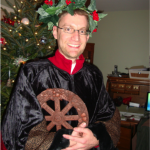Originally posted on July 25, 2011 by John Halstead
“We live in succession, in division, in parts, in particles. Meantime within man is the soul of the whole; the wise silence; the universal beauty, to which every part and particle is equally related; the eternal ONE.” — Emerson
Yesterday I went to a Quaker (Friends) meeting. In part, I was curious about the Society of Friends. But mostly, I wanted to embark on a practice of religious silence, and what better place to start that a Quaker meeting? (Well, perhaps a monastery would have been as good or better, but less convenient)
My interest in Quakerism dates back to my exit from the Mormon church. I was looking for an alternative spiritual practice, and the Quaker theology (of the liberal variety) appealed to me. However, I never actually went to a meeting, as I was pretty exhausted with religious institutions at the time. Years later, one of the members of the Unitarian church I am attending lead the congregation in a mini-introduction to silent worship. He was familiar with the Society of Friends, but not a Quaker himself. Honestly, the service did not do much for me — probably because my daughter was squirming beside me.
But recently, I have felt moved to start a practice of religious silence. This is, at least in part, a reaction to the excessive wordiness that comes naturally to me. But there are other reasons. I had become aware in my studies of Neo paganismthat there is such a thing as a Quaker Pagan or Pagan Quaker … or “Quagan”. (Although the Pagan presence in the Quaker community is at least as controversial as it is in the humanist Unitarian community.)
In the course of researching “Quagans” on the Internet, I came across two phrases: “Hearing where the words come from” and “Seeking the Goddess in Silence”. The first is the name of a Quaker tract and the second is the title of an article about a “Quaker Goddess Network”. What matters, for my purposes, is not what these phrases mean to Quakers, but how they inspired me to a new spiritual practice as I came to identify the Pagan Goddess with the silence where words come from.
I own a book called Word and Silence: Hans Urs von Balthasar and the Spiritual Encounter between East and West by Raymond Gawronski. It is a very dense read that I don’t recommend to anyone. But what I got from it is the idea that God can be experienced not only as the Word-Seed, which is represented by Christ, but also by the Silence-Womb, which is represented by Mary, and that the divine life consists of the union or marriage of these two. In Jungian terms, divinity is both the flowering or birth of consciousness, represented by the Son/Sun of the Goddess, but also the dark Abyss of the Unconscious, represented by the Mother Goddess, and from which the Son/Sun emerges.
Paul Tillich explains it this way: “The divine life is the dynamic unity of depth and form.” He goes on to describe God as both the basis or ground of being and the depth or abyss of being. Tillich explains the meaning of God as ground as “the source from which every form emerges. The ground of being has the character of self-manifestation; it has logos character.” On the other hand, God is “an abyss in which every form disappears.” As Martin Luther King, Jr. explained in his thesis on Tillich: “God as ground forms creation. But God as abyss connotes the fact that no creation can fully express the richness of God. Abyss means for Tillich the depth of the divine life, its inexhaustible and ineffable character.” What this means for humans is that God is both approachable (through the Logos) and inexhaustible (as Abyss).
Contrary to our Western way of thinking, the Abyss is not mere absence or void; it is something (or some place) in itself. And silence is more than the absence of sound; it is something that can be listened to. It is the presence of the absence of God (as Logos), rather than the absence of the presence of God.
The Pagan Goddess is, to my mind, the Abyss and silence, and her consort-son with the consciousness and the Word/Logos. She is the “Pregnant Darkness” (another book title I own: The Pregnant Darkness: Alchemy and the Rebirth of Consciousness by Monika Wikman) which precedes creation and consciousness. She is the watery abyss (Tehom) from the Book of Genesis, which was the primal stuff from which God created the world.
Who shut up the sea with doors, when it brake forth, as if it had issued out of the womb? When I made the cloud the garment thereof, and thick darkness a swaddlingband for it, and brake up for it my decreed place, and set bars and doors, and said, Hitherto shalt thou come, but no further: and here shall thy proud waves be stayed?
— Job 38
While these ideas ideas were gestating in my mind, I came across the list of Delphic Oracles, and two of the 147 stood out of me:
Be (religiously) silent (Ευφημος ιοθι) [#36]
Exercise (religious) silence (Ευφημιαν ασκει) [#115]
I heard these as a call to silent practice and resolved to visit a Friends meeting. I must emphasize that what I am going to describe is not Quaker or even Quagan practice. It is, rather, what I, a Pagan, experienced in a Quaker meeting.
I arrived at the community center where the meetings are held. I was ushered into a pleasant sunlit room with stackable chairs arranged more or less in a circle. About a half dozen people were there and more arrived later. The group began silent worship without any sign. I noticed most people had their eyes closed. Some seemed to be meditating, others more contemplating (if that distinction makes any sense). I didn’t watch the others too closely, though, because I wanted to have my own experience.
What I noticed immediately was that it was not, in fact, silent. There were cars that could be heard outside. The air conditioner kicked on and off. People coughed or sneezed. The children were led in at one point for about five minutes and then led out. For young children, they were very quiet … but not silent by any means. So I quickly realized that the silence I needed to seek was not an external silence, but an internal one. The silence which comes when the internal “Talking Self” is quiet, listening instead of talking. So, in this way, the minor noises actually helped me to appreciate the difference between external silence and internal silence.
This concept of listening was key for me, because it gave me something affirmative to do. Rather than trying not to think, instead I tried to listen. By “listening”, I mean I tried to make the part of myself that normally talks in my head, listen instead of talk. I attended to the absence of internal monologue. I tried to drew my inner attention to “the place where the words come from”.
Eventually, I found my mind wandering, and I redirected it back to the silence. I am familiar with the most common form of sitting meditation, inspired by Buddhism, where one tries not to suppress the flow of thoughts, but to rise above it, to disassociate from it. Frankly, that form of meditation never appealed to me, nor does Buddhist philosophy with its associations of negation and transcendence. Rather than “rising above” my consciousness, I wanted to go deeper, to dive below my thoughts, so to speak. Not to transcend, but to immerse myself. (These water metaphors arise unintentionally, but not accidentally, I think. The Goddess is, after all, the watery womb.)
But I was left wondering what to do with my thoughts. Eventually, after repeatedly emerging from and returning my attention to the inner silence, a metaphor came to me: a visual metaphor of diving into a dark pool and then slowing floating to the top. By drawing my attention to the inner silence and quieting the Talking Self, I dove into the metaphorical dark pool of my unconscious. As images and thoughts began to form again, I floated back to the metaphorical surface. And when I become self-conscious and realized that I had lost the attentiveness to the silence, then I broke the surface of the metaphorical pool and breathed again the air of consciousness. Extending this metaphor, the longer I could maintain my attentiveness to the silence, then the deeper I descend into my unconscious.
I later realized that the images and thoughts that arose before I became self-conscious again were significant, significant in the real sense of that word — as in “signifying”. Far from being a failure in my practice, they were expressions of my unconscious which I should attend to. The “pool” metaphor places both the silence and the emergent thoughts into their proper perspective. I cannot remain in the silence, any more than I could stay forever under the water. I must rise naturally to the surface and breathe again. And then I can dive again, deeper and deeper each time. This cyclical pattern of diving and rising and diving again fits well with the Pagan theme of Eternal Return (Mircea Eliade) or palingenesis, “the eternal recurrence of birth” (Joseph Campbell) expressed in the Wheel of the Year and the myth of the dying and rising gods.
About half way through the hour-long meeting, I wondered why I was there, rather than at home, where I could practice my silence in more quiet. It occurred to me that perhaps there was something about being silent in a group. So I began to attend, not to my inner silence, but to the silence of the group. I should mention that, in the middle of the circle was a microphone which had be laid on a box. It was there, as I understand it, to be used by anyone who feels moved to speak. On this occasion no one did, but there was always that possibility present. And that possibility made the silence feel “pregnant”.
After about 45 minutes, I was depleted and ready to leave. And I noticed other people seem cease their silent worship around the same time. I did not stay to socialize. At the end of the service, I did feel a poignant need, not to speak, but to sing. I enjoyed the silent practice, but I felt it would be complimented by music. Aldous Huxley wrote: “After silence, that which comes nearest to expressing the inexpressible is music.”
I don’t think I will return often to the Quaker meeting, but only because the meeting place is very far from my home. But I am grateful to the Friends for the insights I had there. I am resolved to continue to practice religious silence, if not daily, then at least weekly. Ideally I would like to practice at least five minutes a day. Finding the time and remembering are, of course, the main obstacles, as they are with most spiritual routines. Speaking of which, I am going to stop typing and go practice right now.















